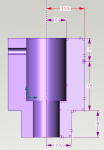daguin
0
- Joined
- Mar 29, 2008
- Messages
- 15,989
- Points
- 113
I like the snap ring idea. It would look nicer than having an exterior set screw IMO. Also, it helps for people who already got their host, so they don't have to ship them all to D_H, they can instead have the snap ring and heat sink shipped to them.
Just FYI -- No one that bought a heat sink from DH during the GB has their Dorcy. ALL of those packages are still here. If you paid for a heat sink and want the host sent separately, please PM me. I am simply trying to save us all postage costs.
If you did not order a heat sink, your Dorcy is either on its way or you already have it.
Peace,
dave






